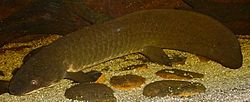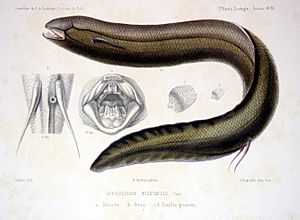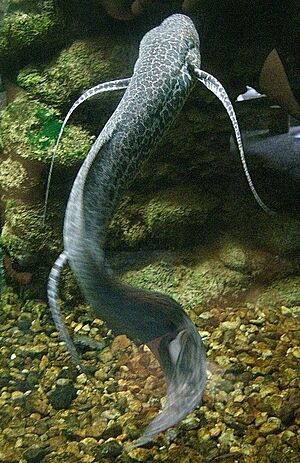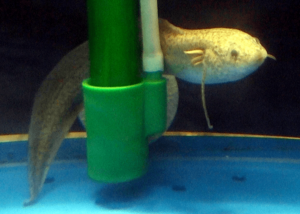Lungfish facts for kids
Quick facts for kids LungfishesTemporal range: Early Devonian - Recent
|
|
|---|---|
 |
|
| Queensland Lungfish | |
| Scientific classification | |
| Kingdom: | |
| Phylum: | |
| Subphylum: | |
| Class: | |
| Subclass: |
Dipnoi
J. P. Müller, 1844
|
| Orders | |
Lungfish are amazing freshwater fish that belong to a special group called Dipnoi. They are related to other ancient fish, like Coelacanths. They are also related to the early lobe-finned fish that eventually evolved into tetrapods, which are animals with four limbs, like amphibians, reptiles, birds, and mammals.
What makes lungfish so unique is that they have both gills and lungs! Most fish only have gills. Lungfish need their lungs because they live in small lakes and rivers that sometimes dry up. When the water disappears, these fish don't die. Instead, they can survive in the mud for a very long time, sometimes up to four years! They use their lungs to breathe air during this time. This special ability to survive dry periods is called aestivation, which is like a deep sleep or dormancy.
Today, there are eight different kinds of lungfish species. Six of these live in Africa, one lives in South America, and one lives in Australia.
Contents
Meet the Living Lungfish Species
There are different types of lungfish alive today, each with its own special features. Let's learn about them!
The Australian Lungfish
The Queensland lungfish, also known as Neoceratodus forsteri, is found only in Australia. This fish is like a "living fossil" because its ancestors have been around for about 380 million years! That's even before the first higher vertebrates (animals with backbones) started to evolve.
Fossils of lungfish that look almost exactly like the Queensland lungfish have been found. This shows that they haven't changed much in over 100 million years. This makes them one of the oldest living groups of vertebrates on Earth. The Queensland lungfish is the most basic type of air-breathing lungfish still alive.
Unlike its African relatives, the Queensland lungfish can survive for several days out of water if it stays moist. However, it cannot survive if the water completely dries up.
The South American Lungfish
The South American lungfish, Lepidosiren paradoxa, is the only lungfish species found in South America. It lives in swamps and slow-moving waters in the Amazon, Paraguay, and lower Paraná River areas.
This fish is an "obligate air-breather," meaning it *must* breathe air to survive. Not much is known about this "scaly salamander-fish." Young ones have gold spots on a black body, which fade to brown or gray as they get older.
Like other lungfish, its jaw bones are fused together. Its pectoral fins are thin and look like threads, while its pelvic fins are a bit larger and set far back on its body. These fins are connected to the shoulder by a single bone, which is very different from most fish. This is similar to how land animals have limbs connected to their bodies. Adult South American lungfish have very small gills that don't work well.
African Lungfish Species
There are four species of lungfish found in Africa. They are quite different from the Australian lungfish.
The Marbled Lungfish
The marbled lungfish, Protopterus aethiopicus, is found in Africa. It has a smooth, long, and cylindrical body with scales that are deeply set in its skin. Its tail is very long and gets thinner at the end. These fish can grow up to 200 cm (about 6.5 feet) long!
Their pectoral and pelvic fins are also very long and thin, almost like spaghetti. When they first hatch, young marbled lungfish have feathery external gills, much like a newt. After about 2 to 3 months, they change (this is called metamorphosis) into their adult form, losing their external gills.
These fish are usually yellowish-gray or pinkish with dark gray blotches. This creates a marbled or leopard-like pattern on their body and fins. The top of their body is darker, and their belly is lighter.
The marbled lungfish has the largest known genome (all the genetic material of an organism) of any vertebrate. It has 133 billion base pairs in its DNA!
The Gilled Lungfish
The gilled lungfish, Protopterus amphibius, is found in East Africa. It is the smallest living lungfish in the world, usually growing to only about 44 cm (1.4 feet) long. This lungfish is usually a uniform blue or slate gray color. It has small or hard-to-see black spots and a pale gray belly.
The West African Lungfish
The west African lungfish, Protopterus annectens, lives in West Africa. It has a noticeable snout and small eyes. Its body is long and eel-like, about 9 to 15 times the length of its head.
It has two pairs of long, thread-like fins. The pectoral fins are about three times the length of its head, and its pelvic fins are about twice the length of its head. Generally, it has three external gills located behind its gill slits and above its pectoral fins.
This fish has cycloid scales embedded in its skin. Its back is olive or brown, and its belly is lighter. It has large blackish or brownish spots on its body and fins, but not on its belly. These lungfish can grow to about 100 cm (3.3 feet) long in the wild.
The Spotted Lungfish
The spotted lungfish, Protopterus dolloi, is another African lungfish. It is found in the Kouilou-Niari Basin in the Republic of the Congo and the Ogowe River basin in Gabon. It also lives in the lower and middle Congo River Basin.
Like other lungfish, Protopterus dolloi can aestivate on land. It does this by surrounding itself with a layer of dried mucus to stay moist. This species can grow up to 130 cm (about 4.3 feet) long.
Images for kids
-
Lateral view of lungs of a dissected spotted lungfish (Protopterus dolloi)
See also
 In Spanish: Peces pulmonados para niños
In Spanish: Peces pulmonados para niños












